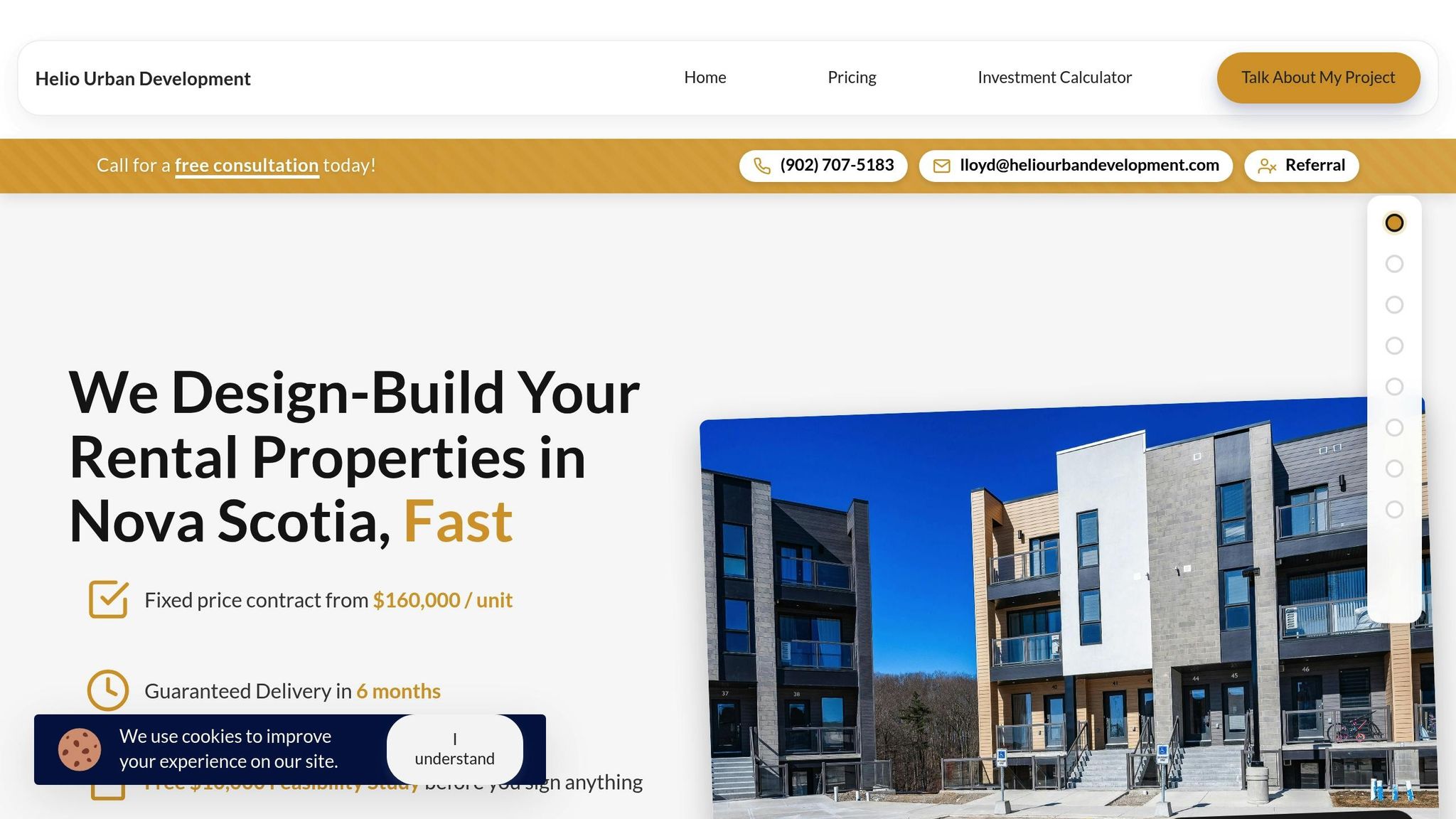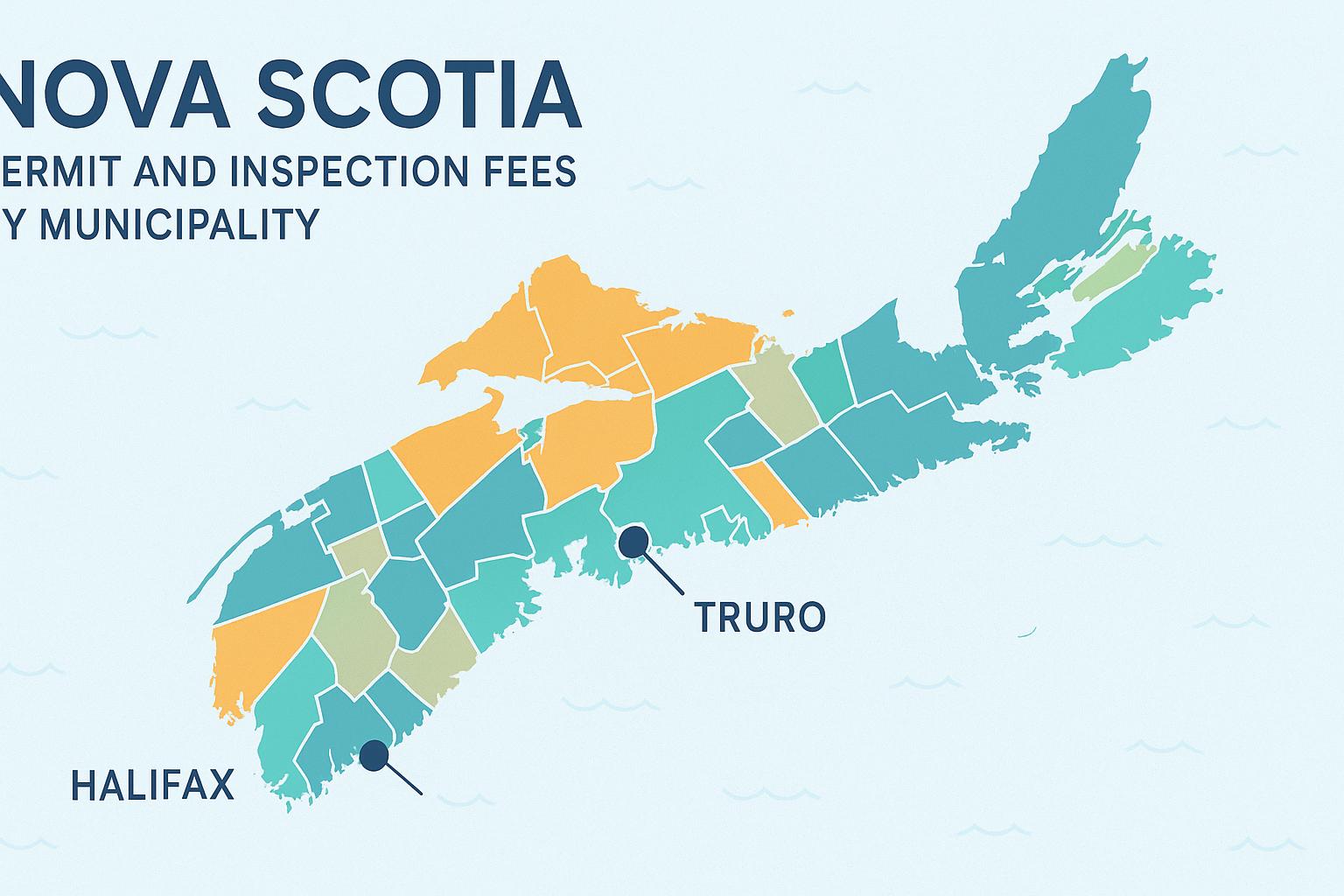If you're building small apartments in Halifax, here's the key takeaway: you no longer need to include parking in most urban developments. The Halifax Regional Municipality (HRM) has removed mandatory parking requirements for residential projects in the Urban Service Area, giving developers flexibility. However, suburban areas still require one parking spot for every three units.
What You Should Know:
- Urban Areas: No parking minimums; focus on transit-friendly designs.
- Suburban Areas: Parking is still required (e.g., 4 spots for a 12-unit building).
- Costs: Parking adds significant expenses - surface parking costs less, but underground parking can exceed $27,900 per space.
- Tenant Preferences: Urban renters prioritize transit, while suburban tenants often rely on cars.
- Future Trends: Electric vehicles and transit infrastructure may reduce parking demand over time.
Bottom Line:
Deciding whether to include parking depends on your location, target renters, and budget. Urban developments may benefit from skipping parking, while suburban projects might still need it to attract tenants. Always weigh the costs, potential rental income, and long-term trends before making a decision.
Halifax Wants URGENT CHANGES to Planning Rules for Housing
Halifax Parking Rules for Small Apartments
If you're working on a small apartment project in Halifax, recent changes to parking regulations could directly affect your plans. The Halifax Regional Municipality (HRM) has introduced new parking requirements, dividing the area into specific zones, each with its own rules. Here's what you need to know.
HRM Parking Rules in 2025
In the Regional Centre, which includes Halifax's urban areas, most residential developments no longer have minimum parking requirements[1]. This approach offers property owners the option to include parking only if it makes financial sense for their project.
Meanwhile, suburban areas have a different standard. Here, the rule requires one parking space for every three residential units[1]. These updated guidelines, introduced under the "Urgent Changes to Planning Documents for Housing", aim to lower construction costs and simplify development processes.
How Building Size and Location Affect Parking Rules
In suburban zones, the parking requirement is directly tied to the size of the building. For example:
- A 12-unit building needs 4 parking spaces.
- An 18-unit building requires 6 parking spaces.
However, in the Regional Centre, a 20-unit building isn't obligated to provide any parking at all. This flexibility allows developers to better manage planning and budgeting for urban projects while adhering to the specific needs of their location[1].
What Halifax Tenants Want: Parking vs Transit Access
Halifax tenants' preferences for parking can vary greatly depending on where they live. This contrast between urban and suburban renters is something developers need to consider carefully.
Urban Renters Lean Towards Transit
In Halifax's downtown core and the surrounding Regional Centre, the availability of well-connected transit systems means many residents see parking as less of a priority. Public transportation often becomes the go-to option for urban dwellers[2].
Suburban Renters Still Depend on Parking
In suburban communities like Dartmouth, Bedford, and Sackville, the story is quite different. Here, the reliance on personal vehicles remains strong, with parking needs only slightly reduced - by about 25% - compared to urban areas[2].
Electric Vehicle Charging Demand
sbb-itb-16b8a48
How Parking Affects Construction Costs and Returns
Including parking in your small apartment project directly impacts construction costs, timelines, and potential rental income. It's essential to weigh the benefits of parking against its costs and the space it takes away from other uses. These decisions should align with earlier considerations of Halifax Regional Municipality (HRM) regulations and tenant preferences, helping you develop a well-rounded parking strategy.
Here’s a closer look at how parking influences costs, rental returns, and project timelines.
Parking Construction Costs in Halifax
In Halifax, the cost of adding parking spaces depends on whether you opt for surface parking or underground parking. Surface parking is typically less expensive since it requires simpler construction processes, avoiding the need for extensive excavation or advanced drainage systems. On the other hand, underground parking is significantly more expensive due to the engineering complexities involved. Factors like waterproofing, ventilation systems, and structural reinforcements all add to the cost. Additionally, local soil and groundwater conditions can further increase expenses, making underground parking a more challenging and costly endeavour.
How Parking Affects Rental Income
Parking availability can also influence rental income, but the impact varies depending on your location. In urban areas, tenants may be less willing to pay extra for parking, especially if public transportation is accessible. Conversely, suburban renters often see on-site parking as a necessity. However, dedicating land to parking - whether surface or underground - can reduce the space available for additional units. While underground parking saves surface area, its higher construction costs don’t always result in rental premiums that justify the investment.
Parking's Impact on Construction Time
Parking doesn’t just affect costs and income; it can also extend construction timelines. Adding parking requires additional steps, such as specialized permitting and engineering reviews. Surface parking involves tasks like grading and drainage, while underground parking demands extensive excavation, waterproofing, and structural work. These added complexities can delay the overall project, pushing back the timeline for generating rental income. Even minor delays can disrupt cash flow, making it vital to factor these potential setbacks into your planning.
At Helio Urban Development, we take a comprehensive approach to tackle these challenges. From permitting to excavation, our coordinated process helps streamline construction, supporting our 6-month construction guarantee. This approach minimizes common delays and ensures a smoother build compared to less integrated construction methods.
How to Decide: Build Parking or Skip It
Deciding whether to include parking in your small apartment project is no small task. It requires careful consideration of three key factors: your property's location and its designation under the Halifax Centre Plan, the financial impact on your project, and evolving tenant preferences. By focusing on these areas, you can craft a parking strategy that aligns with both your budget and market demands.
Evaluate Your Location and Target Tenants
Understanding your property's HRM zoning is essential. It helps determine whether parking is a valuable addition or an unnecessary cost. Halifax Centre Plan guidelines and transit accessibility already play a significant role in shaping tenant behaviour. For instance, in Downtown, Centre, and Corridor zones within the Regional Centre, parking spaces are often not required under the Halifax Centre Plan [3].
Start by identifying your property’s specific designation. Zones like Downtown, Centre, Corridor, Higher-Order Residential, and Established Residential each have their own parking requirements based on transit proximity. For example, ER-3 zones, which are close to transportation links, typically experience lower parking demand [3].
Urban areas with strong transit connections tend to attract tenants who prioritize walkability and public transit access, while suburban locations often appeal to those who rely on personal vehicles. Carefully assess transit options near your property - areas designed for reduced parking needs often draw renters less likely to own cars. Additionally, the Centre Plan encourages mixed-use developments that align with transit routes and active transportation, further reducing the need for extensive parking [3].
Your target demographic also plays a role. Young professionals working downtown might prioritize lower rents over parking, while families or suburban tenants may require vehicle access. Once you’ve identified these location-specific demands, it’s time to evaluate the financial trade-offs.
Compare Financial Returns With and Without Parking
Including parking in your project comes with significant costs, so it’s crucial to weigh these against potential returns. Consider whether the additional rent you could charge for parking would offset the construction and maintenance expenses. Don’t forget the opportunity cost - space used for parking could otherwise accommodate extra units or amenities. Reducing or eliminating parking can significantly cut construction costs, which might allow for more affordable rental options [3].
Ongoing maintenance costs for parking spaces also impact your bottom line. These recurring expenses should be factored into your calculations to determine whether parking is a worthwhile investment.
Plan for Future Tenant Needs
While immediate costs are important, it’s equally vital to think about how tenant preferences might evolve over time. Halifax is placing greater emphasis on public transit, bike infrastructure, and electric vehicles, all of which could influence parking demand in the future. Your parking strategy should reflect these trends to maintain long-term value.
Including electric vehicle (EV) charging stations during construction is a smart move, as this amenity is becoming increasingly desirable. Planning for EV infrastructure now can save you from costly retrofits later.
In transit-oriented zones, parking demand may decline over time, potentially reducing the value of parking investments. Flexible parking solutions, such as surface lots that can be converted into additional rental units or communal spaces, offer adaptability. On the other hand, underground parking represents a more permanent commitment. Emerging options like car-sharing services could also impact tenant vehicle ownership, so it’s worth keeping an eye on these trends.
At Helio Urban Development, we specialize in guiding property owners through these complex decisions. Our integrated design process evaluates your location, target market, and financial objectives to recommend parking strategies that balance profitability with tenant satisfaction. By addressing both current market conditions and future trends in Halifax’s rental landscape, we help ensure your parking decisions are as forward-thinking as your development.
Key Points for Halifax Property Owners
Balancing construction costs with tenant expectations is crucial for maximizing your return on investment (ROI). When it comes to parking, property owners in Halifax need to weigh municipal regulations, construction expenses, and tenant demand. Starting in August 2024, new provincial regulations will remove the requirement for mandatory on-site parking in Halifax's urban service area, giving property owners more flexibility[5]. However, this added freedom comes with the challenge of making informed decisions that optimize profitability.
Parking fees also play a significant role in long-term revenue. If parking costs are bundled into rent, they fall under Nova Scotia's rent cap (approximately 5% annually). On the other hand, charging separately allows for more flexible pricing adjustments[4]. Current market trends in Dartmouth reveal strong demand for parking, with underground spots renting for $60 per month and outdoor spaces fetching between $40 and $50 monthly[4]. Your parking strategy should align with both the location of your property and the needs of your target tenants.
Match Parking Decisions to Your Project
When deciding on parking, it’s important to consider your property’s location and the type of tenants you aim to attract. Tailor your parking investments to reflect the area's transit options and the preferences of your tenant demographic.
How Helio Urban Development Helps With Parking Decisions

At Helio Urban Development, we understand that parking decisions are integral to a project's success. That’s why we incorporate parking considerations into our design-build process from the very beginning. Instead of treating parking as an afterthought, we assess zoning requirements, tenant needs, and financial goals to recommend strategies that help you achieve the best ROI.
Our team evaluates both parking and unit-maximizing scenarios, providing precise cost breakdowns. With a fixed construction cost of $160,000 per unit and a guaranteed six-month timeline, we ensure transparency and reliability.
Our expertise is backed by experience, with 31 units currently under construction in Nova Scotia. We know how critical decisions - like whether to include parking - affect construction costs and rental income. To keep projects on track, we commit to penalties of up to $1,000 per day if timelines are missed, ensuring that delays don’t eat into your rental revenue.
Property owners turn to Helio Urban Development to avoid common challenges like coordination issues, budget overruns, and missed deadlines. By providing clear, data-driven recommendations and a seamless process, we deliver exactly what we promise - on time and on budget.
FAQs
Is it worth including parking in my small Halifax apartment project?
When planning a Halifax apartment project, deciding whether to include parking involves weighing tenant needs, costs, and current market trends. The city’s decision to eliminate parking minimums offers property owners an opportunity to cut construction expenses and build more units, which can improve overall returns.
Recent data shows that skipping parking can lead to higher rental income, particularly in urban areas where tenants often value affordability and convenient access to amenities over having a parking spot. Carefully evaluate whether the potential increase in rental revenue outweighs the expenses of adding parking to determine the best approach for your project.
How are tenant preferences shifting between parking and public transit in Halifax?
In Halifax, there’s a noticeable shift in what tenants value most. Instead of prioritizing parking spaces, many renters are now leaning towards neighbourhoods that offer excellent public transit options and walkable amenities. This change is largely driven by advancements in the city’s transit infrastructure, like the introduction of Bus Rapid Transit and the expansion of ferry services. At the same time, transit-oriented developments are gaining traction, further fuelling this trend.
As Halifax continues to grow, the demand for accessible public transit and walkable communities is becoming a key factor for renters - especially in urban areas. For property owners and developers, this shift is worth paying attention to. Designing small apartment buildings with proximity to transit and walkable amenities in mind could be a smart move to meet the evolving expectations of the rental market.
How will removing mandatory parking requirements in Halifax affect property values and rental demand?
The decision to remove mandatory parking requirements in Halifax's urban areas could reshape property values and rental dynamics. In high-demand locations like peninsular Halifax, a single parking spot can cost more than $30,000, significantly driving up property prices. By eliminating these requirements, developers might cut construction costs and use space more efficiently, potentially making smaller apartment projects more budget-friendly.
As Halifax's downtown population continues to expand, parking demand remains strong. While some tenants view parking as a priority, others might opt for lower rents or prefer living close to public transit - a particularly appealing feature in urban settings. Property owners will need to carefully consider these shifting preferences to stay aligned with tenant needs and market trends.



